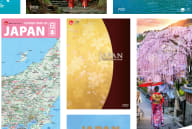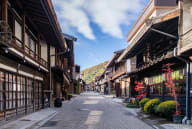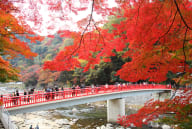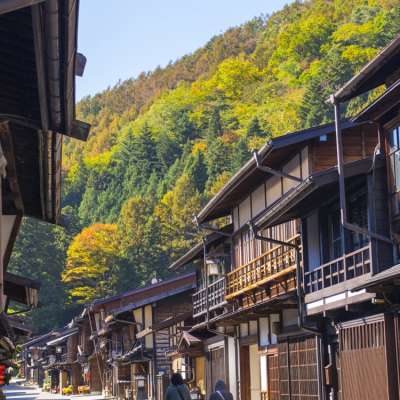
Nagano Discover the taste of alpine perfection
A Culinary Journey in Nagano
Nestled in the heart of Japan, Nagano Prefecture is a land of towering mountains, pristine waters, and a rich agricultural heritage. Known as the "Roof of Japan," its diverse landscapes and varying altitudes create a climate that is perfect for a wide array of crops and livestock.
Nagano is particularly famous for its apples, boasting some of the best in Japan. The region's cool climate and fertile soil contribute to producing apples with exceptional sweetness and crunch. Nagano's soba noodles, made from locally grown buckwheat, are another highlight, cherished for their robust flavour and smooth texture. The prefecture is also known for its high-quality wasabi, which thrives in the clear, cold waters of the region.
In addition to its agricultural bounty, Nagano offers a variety of traditional foods such as Oyaki, a stuffed bun filled with savoury or sweet ingredients, and Shinshu beef, prized for its marbling and tenderness. The area's sake, crafted from pure mountain water and premium rice, completes the culinary experience with its refined taste.
Journey through Nagano's culinary landscape, where each meal reflects a deep connection to the land and its natural resources.
Shinshu soba (Shinshu-style soba)

What it is (ingredients)
Shinshu Soba is a celebrated type of soba noodle from Nagano, made primarily from buckwheat flour and water. The noodles are known for their firm texture and earthy flavour, which comes from the high-quality buckwheat grown in the region's cool climate and pristine mountain water. Shinshu soba is typically served in one of two main styles: Zaru soba (cold soba served with a dipping sauce) and Kake soba (hot soba served in a broth).
Please note: If you're uncertain about having a buckwheat allergy, please be cautious when trying soba in Japan. It's important to watch for any symptoms such as itching or swelling. Consulting with a healthcare provider beforehand is a good idea if you have any concerns.
History/Origin
Shinshu soba traces its origins back several centuries to the Shinshu region (present-day Nagano Prefecture), where the climate and mountainous terrain are ideal for buckwheat cultivation. Buckwheat was first introduced to Nagano by mountain ascetic monks, who shared both the crop and the cultivation methods. Over time, the people of Nagano perfected the art of making soba, transforming this simple dish into a symbol of regional pride and culinary excellence.
Where to Eat
Shinshu Soba can be enjoyed in soba restaurants and traditional eateries throughout Nagano prefecture. Visitors can also find Shinshu Soba in local markets and festivals, where they can taste freshly made noodles and learn about the soba-making process.
When to Eat
Shinshu soba can be enjoyed throughout the year, with variations according to the season. Soba harvested in summer is known as "summer soba." Grown under full sun during midsummer, it matures quickly, offering a strong and vibrant flavour. However, it is slightly less robust compared to "autumn soba," harvested from October to November. Autumn soba is prized for its rich flavour and mellow aroma, as the starch fully ripens during the season's significant temperature fluctuations between day and night.
Experience the authentic flavours of Shinshu Soba and discover why it remains a beloved staple in Nagano and across the country.
Oyaki (Stuffed dumplings)
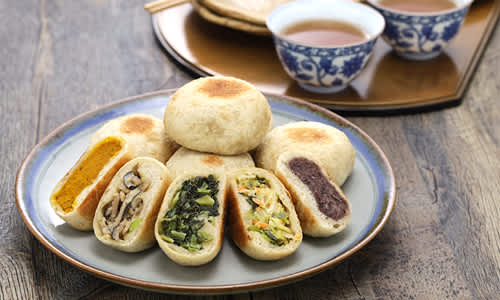
What it is
Oyaki are traditional Japanese dumplings originating from Nagano, known for their simple yet delicious fillings encased in a soft, pillowy dough. The dough is typically made from wheat flour and water, yielding a slightly chewy texture that complements the filling. Common fillings include sweet red bean paste (Anko), vegetables such as spinach or mushrooms, and sometimes even savoury ingredients like miso-marinated pork. Each Oyaki reflects the seasonal ingredients and local flavours of Nagano.
History/Origin
Oyaki has a long history, with evidence of kneading and baking millet flour dating back over 2,000 years, suggesting a "powder food culture" unique to the region has existed since then. Originally, they were crafted as portable snacks for travellers and field workers. Over time, these dumplings evolved to include a variety of fillings, each showcasing the region's agricultural abundance and culinary creativity. Oyaki remains a beloved comfort food and a symbol of Nagano's rich cultural heritage.
Where to Eat
Oyaki can be found in local markets, specialty shops, and festivals throughout Nagano prefecture. Many towns and villages in Nagano have their own variations of Oyaki, each with unique fillings and preparation methods. Visitors can sample freshly made Oyaki at roadside stands or enjoy them as part of a traditional meal in local restaurants and Ryokan (Japanese inns).
When to Eat
Oyaki can be enjoyed year-round, but it's especially popular during the colder months when the warm, hearty fillings are comforting and nourishing. Whether it's a snack, an appetizer, or a light meal, Oyaki offers Nagano's rustic charm and culinary ingenuity.
Discover the delicious flavours of Nagano Oyaki and experience the warmth of a traditional Japanese dumpling made with local ingredients and centuries-old techniques.
Sanzoku-yaki (Marinated fried chicken)

What it is (ingredients)
Sanzoku-yaki is a popular dish from Nagano, known for its large, juicy pieces of marinated chicken that are deep-fried to perfection. The chicken is typically marinated in a mixture of soy sauce, cooking sake, garlic and ginger, infusing it with a rich, savoury flavour. After marinating, the chicken is coated in flour or potato starch and then deep-fried until golden and crispy on the outside while remaining tender and moist on the inside.
History/Origin
Sanzoku-yaki has a relatively short history, having been invented after World War II by the grandfather and wife of the owner of Sanzoku (literally “bandit” in Japanese), an Izakaya (Japanese-style dining bar) in Shiojiri City. Reminiscent of the hearty, simple meals enjoyed by bandits, Sanzoku-yaki has gained popularity for its deliciousness and generous portions. It has become a beloved dish not only among locals but also tourists.
Where to Eat
Sanzoku-yaki can be enjoyed in Izakaya (Japanese-style dining bar), local restaurants, and food stalls throughout Nagano prefecture. Many eateries offer their unique variations of the dish, with different marinades and cooking techniques that highlight the regional flavours. It's also a popular item at local festivals and events, where visitors can experience the vibrant food culture of Nagano.
When to Eat
Sanzoku-yaki is perfect for any occasion, whether as a main dish for dinner, a satisfying snack, or a shareable appetizer with friends and family. Its robust flavours and hearty portions make it a versatile and enjoyable dish year-round.
Indulge in the rich, savoury taste of Sanzoku-yaki, where every bite is a celebration of Nagano's unique and delightful flavours.


















































